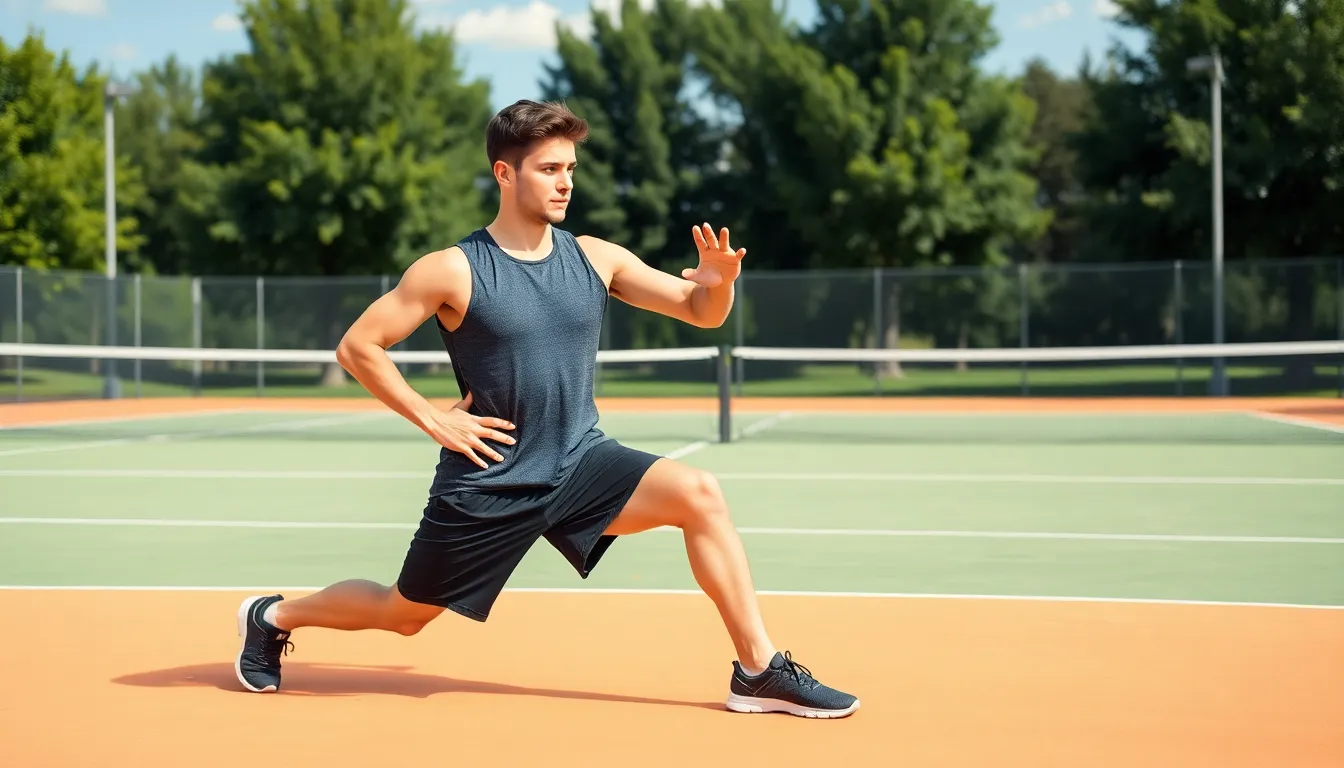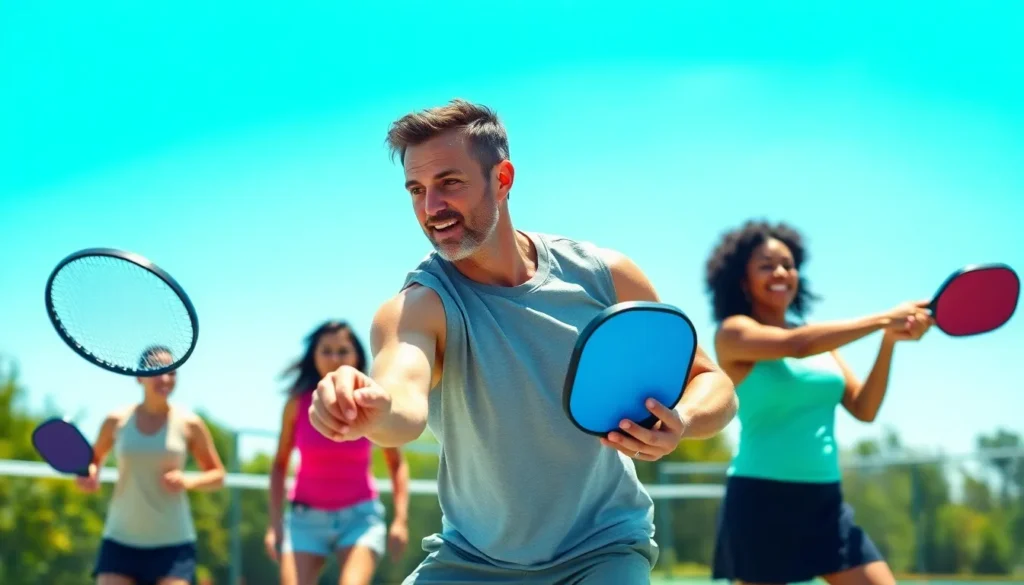Table of Contents
TogglePickleball’s not just a game; it’s a full-body workout disguised as fun. If you think you can just waltz onto the court without breaking a sweat, think again. This sport combines the finesse of tennis with the agility of badminton, demanding a unique blend of strength, speed, and strategy. It’s time to step up your game and embrace pickleball fitness training like a pro.
Understanding Pickleball Fitness Training
Pickleball fitness training enhances overall performance in this dynamic sport. A strong fitness regimen directly impacts agility, endurance, and strength.
Importance of Fitness in Pickleball
Fitness plays a crucial role in the effectiveness of pickleball players. Endurance allows sustaining energy throughout matches. Agility contributes to quick movements and rapid responses during play. Strength supports powerful strokes and effective court coverage. Players who prioritize their fitness often experience improved reaction times and reduced injury risks. A solid fitness foundation helps in executing strategies successfully on the court.
Key Components of Fitness Training
Training for pickleball encompasses multiple fitness aspects. Aerobic conditioning boosts stamina, enabling players to last through long matches. Strength training emphasizes muscle development, enhancing shot power and court mobility. Flexibility exercises improve range of motion and reduce the likelihood of injuries. Balance training helps maintain stability while moving quickly. Incorporating these components into a fitness program enables athletes to excel in their game and build resilience against physical fatigue.
Essential Exercises for Pickleball

Effective pickleball performance hinges on fitness. Incorporating specific exercises enhances agility, endurance, and strength, which contributes significantly to a player’s overall game.
Cardiovascular Conditioning
Cardiovascular conditioning forms the foundation of stamina in pickleball. Engaging in activities such as jogging, cycling, or high-intensity interval training improves heart health and endurance levels. A dedicated aerobic workout for 30 minutes at least three times a week boosts energy during matches. Players should aim to elevate their heart rate, which enhances oxygen delivery to muscles. This increased capacity supports longer rallies and quicker recovery times between points.
Strength Training
Strength training builds the necessary muscle groups used in pickleball. Focus on exercises targeting legs, core, and arms. Squats, lunges, and push-ups enhance power and stability. Performing strength sessions twice weekly ensures muscle endurance continues to develop. Resistance training using bands or weights also promotes injury prevention by fortifying joints and connective tissues. A well-rounded routine contributes to more powerful strokes and improved overall court coverage.
Flexibility and Mobility
Flexibility and mobility play crucial roles in pickleball performance. Stretching exercises should be incorporated regularly to maintain range of motion. Dynamic stretches before play prepare muscles, while static stretches afterward aid recovery. Allocating time for yoga or Pilates can enhance core strength and flexibility. Improved mobility allows players to reach difficult shots and recover quickly, ensuring they maintain balance and control during gameplay.
Creating a Pickleball Fitness Training Plan
Developing a structured fitness training plan enhances performance in pickleball. Addressing specific fitness components gives players an edge on the court.
Assessing Your Current Fitness Level
Understanding current fitness levels is crucial. Players can evaluate endurance, strength, flexibility, and agility through various assessments. A simple method involves functional tests for balance and mobility, while timed drills can reveal speed and stamina. Recording results provides a baseline for future progress tracking. This assessment allows players to identify weaknesses and prioritize improvement areas, ensuring a tailored training approach.
Setting Realistic Goals
Goal setting guides training focus. Players should establish both short-term and long-term objectives that align with their fitness evaluations. Specific objectives could include increasing aerobic capacity by a certain percentage, improving strength for key muscle groups, or enhancing flexibility to support movement efficiency. Setting achievable milestones fosters motivation and allows for adjustments as fitness levels change. This structured approach keeps athletes committed to their training regimen and encourages steady progress.
Sample Training Schedule
A balanced training schedule helps incorporate essential fitness elements. Players might follow a weekly routine that includes three days of strength training, two days of cardio exercises, and dedicated stretching sessions. For instance, Monday and Thursday could focus on strength with exercises like squats and lunges, while Tuesday and Friday emphasize cardio, incorporating jogging or interval workouts. Including rest days is vital for recovery, while dedicated flexibility sessions on off days support mobility. Following this schedule promotes overall fitness growth and peak performance on the court.
Nutrition and Recovery for Pickleball Players
Nutrition plays a vital role in a pickleball player’s performance and overall health. Consuming a balanced diet with adequate carbohydrates, proteins, and healthy fats enhances energy levels, aids in muscle recovery, and supports optimal performance during matches. Hydration significantly impacts endurance, so it’s crucial to drink enough water before, during, and after activities. For instance, incorporating fruits like bananas or energy bites as snacks can provide quick energy boosts on the court. Meals should emphasize lean proteins, whole grains, and plenty of vegetables to ensure necessary nutrients.
Recovery techniques are equally essential for pickleball players. Prioritizing recovery minimizes fatigue and helps prevent injuries. Techniques like foam rolling or gentle stretching promote blood flow and reduce muscle soreness. Furthermore, getting quality sleep allows the body to repair and rejuvenate. Utilizing ice baths or contrast baths can alleviate inflammation post-game. Scheduling rest days into training plans ensures muscles recover and adapt, enhancing long-term performance. Adopting these recovery strategies contributes to sustained energy and improved athletic output.
Pickleball fitness training is crucial for anyone looking to elevate their game. By focusing on components like aerobic conditioning strength training flexibility and balance players can significantly enhance their performance on the court. A well-rounded fitness regimen not only boosts agility and endurance but also reduces the risk of injury.
Incorporating proper nutrition and recovery strategies further supports athletes in maintaining peak performance. With a structured training plan tailored to individual needs players can achieve their goals and enjoy the many benefits that pickleball has to offer. Prioritizing fitness is the key to unlocking full potential in this dynamic sport.




